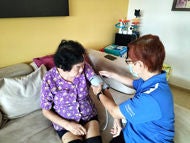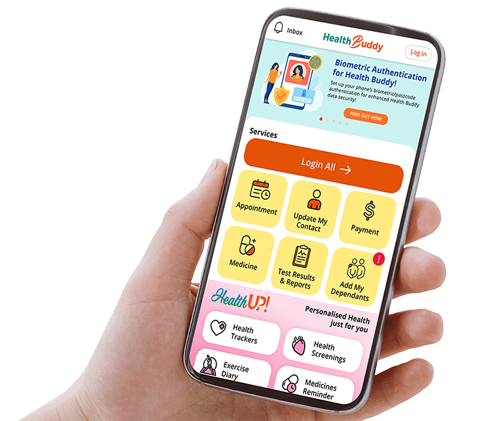Assoc Prof Ng Lay Guat
Director, Clinical Services, SingHealth Duke-NUS Pelvic Floor Disorders Centre;
Senior Consultant, SingHealth Duke-NUS Transplant Centre;
Department of Urology, Singapore General Hospital;
Division of Surgery and Surgical Oncology, National Cancer Centre Singapore

Overactive bladder is a common clinical condition seen in primary care with many of these cases presenting with no identifiable cause. We share a structured and evidence based approach on how idiopathic overactive bladder can be managed and treated in primary care.
INTRODUCTION
Overactive bladder (OAB) is a common clinical condition encountered in primary care, characterised by urinary urgency, usually accompanied by frequency and nocturia, with or without urge incontinence, in the absence of urinary tract infection (UTI) or other obvious pathology.
When no identifiable cause is found, the condition is termed idiopathic OAB. This condition affects an estimated 12-16% of adults, roughly 30% of women and 16% of men, increasing with age.
Early recognition, comprehensive assessment and effective management are essential components of primary care practice.
This article aims to provide primary healthcare physicians with a structured and evidence-based approach to the assessment and management of idiopathic OAB, focusing on essential history-taking, physical examination, appropriate investigations, and both non-pharmacological and pharmacological treatment options.
UNDERSTANDING IDIOPATHIC OVERACTIVE BLADDER
Definition
According to the International Continence Society (ICS), OAB is defined by a symptom complex that includes:
- Urgency (the sudden, compelling desire to void that is difficult to defer)
- Usually accompanied by:
- Increased daytime frequency
- Nocturia
- With or without urgency urinary incontinence (UUI)
Idiopathic vs. Secondary OAB
OAB may be classified as:
- Idiopathic: No underlying pathology found
- Secondary: Due to identifiable causes like neurological diseases (e.g., Parkinson’s disease, multiple sclerosis), bladder outlet obstruction, UTI, bladder stones or malignancy.
The focus here is on idiopathic OAB, where the diagnosis is made after ruling out secondary causes.
A Structured and Evidence-Based Approach to the Assessment and Management of Idiopathic OAB
1. ESSENTIAL HISTORY
History-taking is the cornerstone of OAB assessment. It provides the context for diagnosis and guides further evaluation.
A. Presenting Symptoms
Ask about the four hallmark symptoms:
- Urgency: Onset, frequency, and severity
- Frequency: Number of voids per day(>8 is abnormal)
- Nocturia: Number of voids at night
- Urge incontinence: Frequency and impact on daily life
B. Precipitating or Relieving Factors
- Caffeine, alcohol, fluid intake
- Diuretic use
- Cold weather or specific triggers
C. Voiding and Continence History
- Pain on urination (suggests UTI or bladder pathology)
- Hesitancy, weak stream, straining (suggests BPH in men)
- Incomplete emptying
- Stress incontinence (when sneezing, coughing or laughing)
D. Medical and Neurological History
- Diabetes mellitus
- Stroke, spinal cord injury, multiple sclerosis
- Parkinson’s disease
- History of pelvic surgery or radiation
E. Medications
- Diuretics
- Anticholinergics
- Alpha-adrenergic agonists or antagonists
- Sedatives
- SGLT2 inhibitors
F. Obstetric and Gynaecologic History (in women)
- Parity
- Vaginal deliveries, instrumental deliveries
- Pelvic organ prolapse
- Menopause
G. Impact on Quality of Life
Ask how the condition affects:
- Sleep, Work, Social interactions, Sexual activity
2. PHYSICAL EXAMINATION
A. General Examination
- Cognitive assessment in elderly patients
B. Focused Exam to Rule Out Alternative Causes
- Abdominal exam: Palpable bladder suggests retention
- Genital/pelvic: Check for prolapse, atrophy, signs of oestrogen deficiency, pelvic floor power
- Digital rectal examination (in men): Assess prostate size and consistency
- Neurological examination: Perineal sensation, anal tone and reflexes, gait and coordination
3. INVESTIGATIONS
Investigations are aimed at excluding secondary causes and establishing a baseline.
A. Urinalysis
- To rule out infection, haematuria or glycosuria.
- If positive for nitrites or leukocyte esterase, send urine culture.
B. Bladder Diary
- A 3-day record of fluid intake, voiding times, volumes, incontinence episodes, urgency and pad use provides a more objective picture for the symptoms.
- Figure 1 shows a typical bladder diary of a patient with OAB. Note that the patient indicated urine urgency (U) with 50-100 ml voided. ‘w’ indicated wet and ‘p’ indicates change of pad. Assessment of post-void residual urine in the patient with this diary is important to differentiate between a patient with OAB and one of voiding dysfunction.
- Figures 2 and 3 illustrate the importance of a bladder diary of patients also presenting with urinary frequency, urgency and nocturia, but figure 2 shows that the cause is that of polydipsia, and figure 3 shows a picture of nocturnal polyuria.

C. Post-void Residual (PVR) Volumem
- Measured by bladder ultrasound or catheterisation
- A normal PVR is <50 ml; >200 ml may suggest retention or detrusor under activity.
D. Urine Cytology (if haematuria)
To rule out bladder malignancy, especially in older adults or smokers.
E. Serum PSA and Renal Panel
F. Imaging (Selective)
- Renal and bladder ultrasound if obstruction orstones are suspected.
- MRI spine if neurological symptoms are present.
Diagnosis
Idiopathic OAB is a clinical diagnosis made after:
- Excluding infection, structural and neurological causes.
- Confirming the symptom complex of urgency, with or without frequency, nocturia and urge incontinence.
4. MANAGEMENT
The management of idiopathic OAB should be stepwise and patient-centred, starting with non-pharmacological then pharmacological strategies.
Step 1: Lifestyle and Behavioural Interventions
A. Patient Education
- Reassure the patient that OAB is common and treatable.
- Discuss the chronic nature and the need for long-term management.
B. Lifestyle Modifications
- Reduce bladder irritants: caffeine, alcohol, citrus, spicy foods.
- Limit fluid intake in the evening.
- Weight loss in overweight patients.
C. Bladder Training
- Scheduled voiding to gradually increase interval between voids.
- Set slow realistic incremental goals, to reach a target voiding volume of 200-300 ml per void.
- Delay voiding with techniques like distraction or pelvic contraction.
D. Pelvic Floor Muscle Training (PFMT)
- Particularly effective in women with urge incontinence.
- May require referral to a physiotherapist.
E. Manage Constipation
- Encourage fibre intake, adequate hydration and physical activity.
Step 2: Pharmacological Therapy
Initiate pharmacotherapy if conservative measures fail after 4-6 weeks.
A. Antimuscarinics
- Examples: Oxybutynin, Tolterodine, Solifenacin, Trospium
- Mechanism: Inhibit muscarinic receptors in bladder smooth muscle, reducing involuntary contractions
- Side effects: Dry mouth, constipation, blurred vision, cognitive effects (especially in older adults), retention of urine
B. Beta-3 Adrenergic Agonists
- Example: Mirabegronm Mechanism: Relax detrusor muscle, increasing bladder capacity.
- Side effects: Hypertension, headache, nasopharyngitis
- Advantage: Better tolerability in elderly
C. Adjunctive/Other Therapies
- Vaginal oestrogen in postmenopausal women with urogenital atrophy
- Off-label agents: TCAs (imipramine), SNRIs (duloxetine) in specific cases; watch side effects
D. Combination Therapy
- In resistant cases, consider combining antimuscarinic with beta-3 agonist.
Step 3: Referral and Advanced Therapies
A. Refer to a Urologist if
- No improvement after 8-12 weeks of treatment
- Atypical features or haematuria
- Neurological signs
- Suspected bladder outlet obstruction
B. Advanced Options Include
- Botulinum toxin A injections into the bladder wall
- Percutaneous tibial nerve stimulation (PTNS)
- Transcutaneous tibial nerve stimulation (TTNS)
- Surgical options (rare)
Antimuscarinic Drugs Available in Singapore
| Drugs | Action | Side Effects | Comments |
| Oxybutinin | Mixed action | • Dry mouth |
• Cheapest in market, great forshort-acting usage e.g., prn when going out • Significant cognitive AE –avoid long-term in elderly |
| Tolteridine | Non-selective for M3 receptors | • Dry mouth • Constipation • CNS effect • No sig effect on or QTc heart rate • QT interval precaution with some CV drugs |
• Takes several weeks for onset of actions • Once stabilised can be very effective |
| Solifenacin | SelectiveM3 receptor antagonist | • Dry mouth • Constipation • CNS effect • Minimal QTc prolongation |
• Takes a couple of days for onset of action |
| Trospium | Non-selective for M3 receptors | • Dry mouth • Constipation • No CNS or cardiac effect |
• AE with dry mouth and constipation • NO cognitive se – most suitable for elderly and underlying CNS issues |
| Imipramine | Tricyclic antidepressant | • Somnolence in day • Bladder relaxation is a side effect! |
• If OAB symptoms is associated with insomnia – can be tried |
| Mirabegron | Beta-3 agonist | • Tachycardia, hypertension | • No generic available; so can be costly |
Follow-up
- Reassess symptoms and side effects within 4-6 weeks of treatment.
- Use bladder diary and patient-reported outcomes to guide management.
- Repeating post-void residual urine after commencing medications.
- Monitor for adherence and consider stopping if ineffective or poorly tolerated.
Special Considerations
In Elderly Patients
- Be cautious with anticholinergics due to risk of cognitive decline.
- Mirabegron is generally preferred.
- Assess fall risk due to urgency and incontinence.
In Men
- Evaluate for benign prostatic hyperplasia (BPH); dual pathology is common.
- Combination therapy with alpha-blockers may be required.
CONCLUSION
Idiopathic overactive bladder is a common yet under diagnosed condition that can significantly impair quality of life. Primary healthcare physicians play a pivotal role in its early detection and management. A thorough clinical assessment, focused physical examination and selective investigation help rule out secondary causes and confirm the diagnosis.
Management should begin with non-pharmacological measures, progressing to medication as the next line of therapy, and finally referral to urologists for third-line treatment.
REFERENCES
1. Irwin DE, Milson I, Hunskaar S, et al. Population-based survey of urinary incontinence, overactive bladder, and other lower urinary tract symptoms in five countries: results of the EPIC study. EurUrol. 2006;50(6):1306–1314. doi:10.1016/j.eururo.2006.09.0192.
2. Nambiar AK, Bosch R, Cruz F, et al. EAU guidelines on assessment and nonsurgical management of urinary incontinence. EurUrol.2018;73(4):596–609. doi:10.1016/j.eururo.2017.12.0313.
3. Abrams P, Cardozo L, Wagg A, Wein A, editors. 6th international consultation on incontinence. Tokyo; 2016.
4. Lightner DJ, Gomelsky A, Souter L, et al. Diagnosis and treatment of overactive bladder (non-neurogenic) in adults: AUA/SUFU guideline. J Urol. 2019;202:558.doi:10.1097/JU.0000000000000309.
5. Gormley EA, Lightner DJ, Burgio KL, et al. Diagnosis and treatment of overactive bladder (non-neurogenic) in adults: AUA/SUFU guideline. J Urol. 2012;188:2455.doi:10.1016/j.juro.2012.09.079.
Assoc Prof Ng Lay Guat
Dr Ng Lay Guat obtained her Female Urology & Adolescent Urology Fellowship after spending one year at the Institute of Urology, London, UK from 2002 to 2003. Her clinical interests include Adolescent & Reconstructive Urology, Functional & Neuro-Urology and Renal Transplantation.
Dr Ng is the past Head of Department, Senior Consultant and Director of Female Urology & Transplant, Department of Urology, Singapore General Hospital. She was the award winner of the Chapter of Surgeon’s Gold medal in 1996 and winner of Yahya Cohen medal in 1996.
GPs can call the SingHealth Duke-NUS Pelvic Floor Disorders Centre for appointments at the following hotlines:
Singapore General Hospital 6326 6060
Changi General Hospital 6788 3003
Sengkang General Hospital 6930 6000
KK Women’s and Children’s Hospital 6692 2984



















